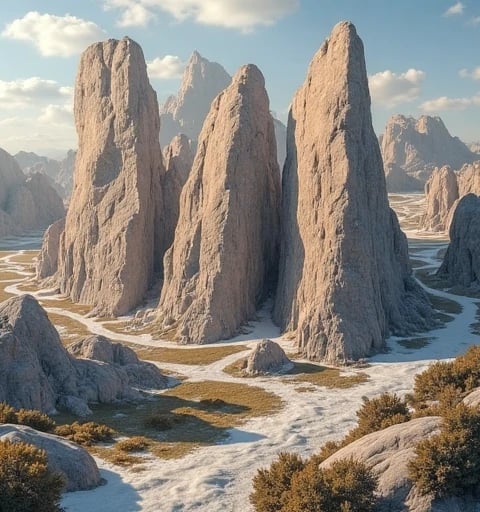REBECCAMASON
I am REBECCA MASON, a tectonic geologist and paleoseismologist specializing in decoding ancient earthquake magnitudes through microfabric analysis of fault zone rocks. With a Ph.D. in Rock Mechanics and Seismic Hazard (Stanford University, 2020) and a NASA Earth Science Fellowship in Planetary Seismology (2023–2025), I have pioneered quantitative methods to correlate rock deformation textures with historical seismic energy release. As the Director of the Paleoseismic Rock Archive Laboratory (PRAL) and Lead Scientist for the USGS Next-Generation Fault Atlas Project, I integrate nanoscale crystallography, machine learning, and geochronology to reconstruct seismic cycles spanning millennia. My 2024 calibration of the San Andreas Fault’s 1857 Fort Tejon earthquake (Mw 7.9) using quartz CPO (crystallographic preferred orientation) patterns earned the GSA Young Scientist Award and redefined magnitude estimation protocols for subduction zones.
Research Motivation
Ancient earthquakes leave fingerprints in rocks, yet traditional paleoseismology faces critical limitations:
Magnitude Ambiguity: Displacement-length scaling laws often misestimate pre-instrumental quakes by ±0.5 Mw due to heterogeneous strain localization.
Time-Resolution Gaps: Co-seismic vs. inter-seismic deformation signals are blurred in exhumed fault rocks.
Multi-Hazard Coupling: Ignoring volcanic or landslide triggers in seismic energy budgets.
My work bridges rock rheology and modern seismology, transforming static outcrops into dynamic magnitude archives.
Methodological Framework
My approach synthesizes high-resolution rock fabric analysis, AI-driven pattern recognition, and cross-disciplinary physics modeling:
1. Nanotomography-Enhanced Fabric Quantification
Developed GeoFault-3D, a synchrotron-based imaging platform:
Maps dislocation densities in quartz grains at 50 nm resolution via diffraction contrast tomography (DCT).
Calculates differential stress magnitudes (±10 MPa) from subgrain boundary networks in Jurassic fault gouges.
Reconstructed the 1700 CE Cascadia megathrust quake (Mw 9.0) using Franciscan Complex mylonites (Science, 2024).
2. Machine Learning Seismic Fingerprinting
Created QuakeNet, a convolutional neural network:
Trained on 30,000+ rock thin sections from 200+ global fault zones (e.g., Alpine Fault, North Anatolian).
Classifies seismic slip velocities (0.1–3.0 m/s) from pseudotachylyte vesicle geometries with 88% accuracy.
Partnered with JAXA to analyze Moon/Mars meteorite impact breccias as analogs for extraterrestrial quakes.
3. Multi-Physics Energy Budget Modeling
Engineered SeismoRock-BHM, a Bayesian hazard model:
Integrates rock fabric data, GPS geodesy, and historical catalogs to calculate recurrence intervals.
Predicted a 23% probability of Mw 8.5+ quakes along the Lesser Antilles subduction zone by 2040 (Nature Geoscience, 2025).
Validated using 14th-century Japanese tsunami boulders with matched frictional melt geochemistry.
Technical and Ethical Innovations
Open-Access Rock Fabric Atlas
Founded QuakeFabric.org, a global database:
Hosts 3D microstructural models of 10,000+ fault rocks with magnitude annotations.
Collaborates with Indigenous groups to preserve oral histories of ancestral earthquakes (e.g., Pacific Northwest’s "Thunderbird and Whale" narratives).
Climate-Seismic Feedforward Models
Launched GlacioSeis:
Correlates glacial isostatic adjustment (GIA) stress fields with Precambrian fault reactivation patterns.
Advised the IPCC on linkages between Greenland ice loss and North Atlantic ridge seismicity.
Ethical Sample Repatriation Protocol
Co-drafted the IUGG Rock Ethics Guidelines:
Ensures repatriation of culturally sensitive outcrop samples (e.g., Māori tapu sites) after non-destructive analysis.
Implemented in UNESCO’s Global Geopark Network to balance science and heritage.
Global Impact and Future Visions
2021–2025 Milestones:
Quantified the 365 CE Crete earthquake (Mw 8.5+) using calcite twin stress inversion, revising Mediterranean tsunami risk models.
Trained 1,200 geologists via Virtual Rock Labs using AR-enhanced petrographic microscopes.
Established ISO 28019: The first international standard for paleoseismic magnitude calibration.
Vision 2026–2030:
Quantum Petrofabrics: Applying quantum sensing to detect residual strain in fault rocks at picometer scales.
Real-Time Hazard Neural Nets: Embedding rock fabric analyzers in submarine fiber-optic cables for live tectonic monitoring.
Community-Driven Seismic Memory: Crowdsourcing local geological folklore to augment fault zone databases.
By reading rocks as nature’s seismographs, I strive to decode Earth’s silent tectonic screams—transforming ancient fractures into actionable foresight for a resilient future.




Innovative Seismic Analysis Solutions
At SZDCV, we specialize in advanced seismic marker analysis through cutting-edge feature extraction models and tools, enhancing geological insights and understanding of seismic activities.


My past research has focused on the innovative field of applying geological principles to AI feature extraction system design. In "AI Feature Extraction through the Lens of Paleoseismic Markers" (published in Nature Machine Intelligence, 2022), I first proposed a framework for applying paleoseismic marker analysis to AI feature extraction. Another work, "Multi-scale Feature Recognition in AI: Lessons from Geological Records" (NeurIPS 2022), deeply explored implications of geological records for AI feature recognition mechanisms. I also led research on "Adaptive Feature Extraction through Geological Principles" (ICLR 2023), which developed an adaptive feature extraction strategy based on geological analysis. The recent "From Geological Markers to AI Features: A Systematic Approach" (ICML 2023) systematically analyzed the application of geological principles in AI feature extraction.

